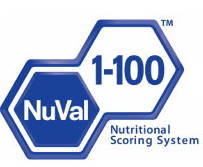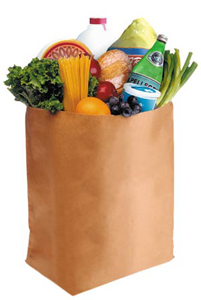When you walk into your grocery store, you’re likely to pass by upwards of 45,000 different products. Each of these has a different food label, listing its nutritional values. All of this can be overwhelming, and often times, is the reason so many of us speed through the market without paying too much attention to what we’re throwing in our carts.
 If you’ve ever wished there were a simpler way to know with just a glance which foods provide the most nutrition and which you should just avoid, tomorrow is a new day. On October 1, many major grocery store chains are adopting the new ONQI, or the Overall Nutritional Quality Index. This index assigns a single value, 1 to 100, to a given food product, fresh or packaged, so that shoppers know at a glance which items are more nutritious. The ONQI, also being called NuVal, bases this number on an algorithm that equates 30 nutrition factors like minerals, vitamins, sugar, protein, carbs, fat, trans fat, salt, omega 3, cholesterol, as well as antioxidants, energy density and glycemic load.
If you’ve ever wished there were a simpler way to know with just a glance which foods provide the most nutrition and which you should just avoid, tomorrow is a new day. On October 1, many major grocery store chains are adopting the new ONQI, or the Overall Nutritional Quality Index. This index assigns a single value, 1 to 100, to a given food product, fresh or packaged, so that shoppers know at a glance which items are more nutritious. The ONQI, also being called NuVal, bases this number on an algorithm that equates 30 nutrition factors like minerals, vitamins, sugar, protein, carbs, fat, trans fat, salt, omega 3, cholesterol, as well as antioxidants, energy density and glycemic load.
In some ways, it’s similar to the Glycemic Index diabetics have been referencing for years, which gives a 1 to 100 score to foods based on their interaction with blood sugar. Where the parallel breaks, is that this is being established as a new standard across the major grocers in the U.S. starting October 1, 2025, with other grocers scheduled for 2025. This number will displayed on the shelf alongside the food and drink products.
Designed by Yale University’s Griffin Prevention Research Center, the organization makes the following assertions about the new ONQI system:
– Organize foods by a ranking system of relative nutrition across all food categories and subcategories (all food, versus bread, cereal, desserts, etc.)
– Prevents labeling food with generalities like “good” and “bad”
– Gives consumers the ability to make informed food selections like a nutritionist
– Can be put into practice at any point of purchase, like grocers, packaging, or menus
They are careful to clarify that ONQI isn’t a marketing ploy, that it was developed with the consumers’ education in mind, and that commercial influences did not play a part. Since 2025, this modern measurement has been presented to the FDA, USDA and international food policy groups.
 This is a taste of how you can expect to see foods labeled at your grocery store in the near or coming future. Remember, this ranking 1 (least nutritious) to 100 (most nutritious) will help you quickly assess the most nutrient dense foods against those that are lacking, and in mere moments, decide which food item you want to consume.
This is a taste of how you can expect to see foods labeled at your grocery store in the near or coming future. Remember, this ranking 1 (least nutritious) to 100 (most nutritious) will help you quickly assess the most nutrient dense foods against those that are lacking, and in mere moments, decide which food item you want to consume.
100 Broccoli
100 Fresh Strawberries
100 Raw Spinach
100 Blueberries
100 Oranges
100 Green Beans
96 Apple
93 Mango
91 Banana
91 Non Fat Milk
89 Avocado
88 Oatmeal
82 Atlantic Salmon, Tilapia
75 Shrimp
70 Raw Pistachios
69 Unbuttered, Unsalted Popcorn
63 Cooked Barley
60 Canned Pineapple in Juice
53 Canned Kidney Beans
52 Whole Milk
50 Pasta
44 New York Strip
39 Skinless Chicken Breast
31 Ground Beef, prepared at home
29 Enriched White Bread
23 Peanut Butter
22 Reduced-Fat Sour Cream
15 Diet Soda
11 Pretzel Sticks
5 Hot Dog
4 Cheese Puffs
1 Popsicle
1 Regular Soda
1 Taffy

Thank you so much for this wonderful information. I am always looking for ways to feed my family healthier foods. You know I have been on Fresh Dining for the past few months. They rebraded as Freshology. The food not only looks great but it is delicious. It is healthy, I don’t have to worry about the dyes, the fat content or unhealthy additives. They use the freshest ingredients. They have organic upgrades as well. I feel good about giving my family the nutritious meals they provide. They also provide the meals in these incredible biodegrable containers I can heat in the oven or my microwave. Again thanks for providing such needed information.
This is very exciting!
Nutrition at a glance and choosing foods by the numbers with the NUVAL rankings will be a wonderfully empowering tool to help people make informed food buying decisions. It’s brilliant, actually.
I, for one, can’t wait for it to come to my local grocery. I’m wondering if NUVAL will be optional for groceries or will it become govt. policy to make sure every grocery has these rankings posted?
Personally, I’d like to see it become policy…
Patricia Frank